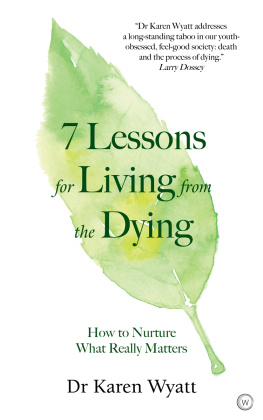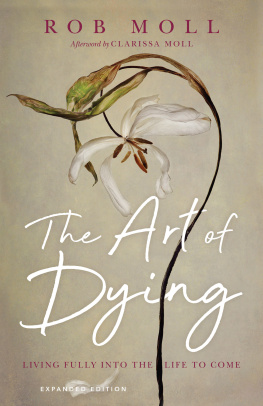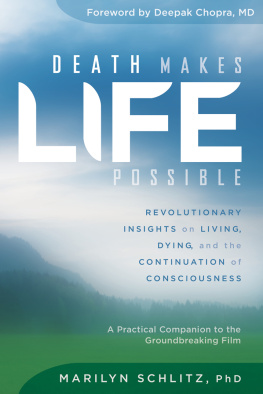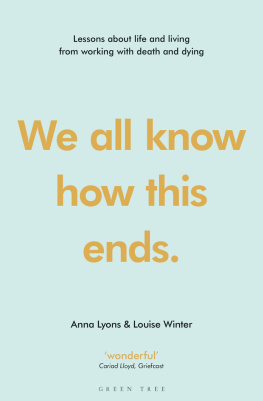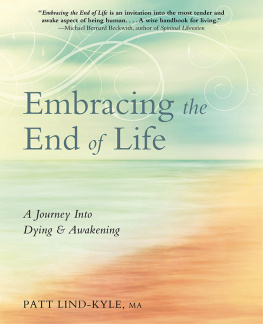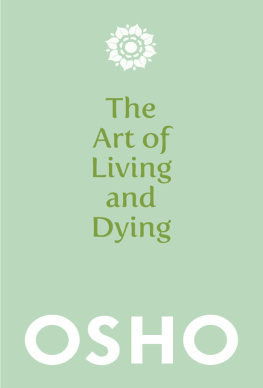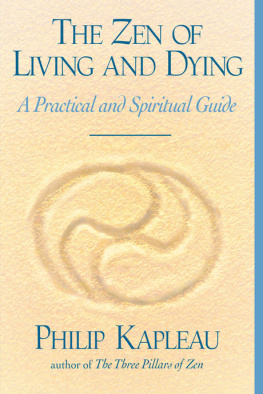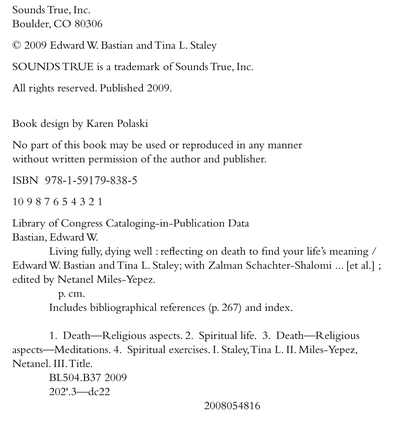This book is comprised of two distinct parts. The first is a dialogue between a number of leading spiritual teachers, scientists, and social workers concerning the spiritual, medical, scientific, and psychological aspects of dying, as well as their perspectives on the afterlife. The second part is an independent collection of resources: guided meditations, life-review practices, affirmations, and reflections. While Part I is intended to be read sequentially in order to answer questions and give new perspectives, Part II can be used according to your own interest or need; no particular order need be followed. However, for those of you who are inspired to use Parts I and II in a more integrated fashiondoing the exercises in coordination with the textvarious parallel exercises from Part II are referenced in the text where similar exercises are mentioned. Ed.
Introduction
Not so long ago, I found myself propped up in bed, gazing at the light flooding through my window and feeling tremendously grateful for one more day of life. In that pristine stillness of dawn, as the dark of night was transformed into the light of dayI was reborn. After a second brush with death, I felt I had genuinely awakened to something new, to a kind of love and gratitude that at sixty years old I had never known before.
Over the last several years, death has become so present for menot in a morbid or fearful way, but as an inescapable reality to understand, to prepare for, and hopefully to move through with wisdom, compassion, and purpose. For me, there was no avoiding it; over a relatively short span of time I had lost my father, Kenneth, my beloved little brother, Kenny, my dear cousin Bruce, several uncles, and many close friends, andtwiceI had nearly lost my own life. The first time, I was thought to be dead from the sting of a single bee.
THE WAKE-UP CALL
It happened on a snowy winter night in 1997. I walked through the door of my home in Woody Creek, near Aspen, Colorado, with my friend George Stranahan after a neighborhood meeting to chat a bit before he headed home. We strolled into the living room, shed our winter boots, and I slipped on a pair of warm slippers. Immediately, I felt a painful sting on the bottom of my right foot. The sting was a shock, but I wasnt worried since I had never been allergic to bee stings before. I kicked off the slipper and out dropped the bee, which I gently deposited in the snow outside my door for his last moments of life. George began to kid me about not being a good Buddhist, sending the poor bee out to a certain death in the freezing snow. I reminded him that the bee was about to die anyway, having lost his stinger, and that the cold would numb him into sleep, and he would die peacefully.
George, of course, didnt buy this and continued to kid me.
I turned on the cold water in the kitchen sink and stuck my foot under the water to bring down the swelling. Then, pulling a couple of beers out of the refrigerator, George and I were just about to sit down for a chat when I suddenly felt dizzy. George, I said, something is happening... Alarmed at my expression, he led me to a seat where I collapsed and began to lose consciousness. The last thing I heard was George calling 911.
The next thing I remember was being spread out on my back on the living room floor fighting to breathe. Looking up over the edges of an oxygen mask, I saw the cigarette-toting face of my next-door neighbor, Hunter S. Thompson, the famed Gonzo journalist, yelling at me, Live, damn it, live! Other neighbors, Jillian and Oliver, were also standing around me with deep concern on their faces. Hunter had been called by my good friend, Sheriff Bob Braudis, who heard the 911 ambulance call from his walkie-talkie at home. When Hunter received the call, he and our buddy Oliver had rushed up to my house.
The paramedics lifted me onto a stretcher and hauled me off to the hospital. Lying there on my hospital bed, it began to dawn on me what had just happened. After all my years of study of Buddhism and spiritual practice, in both India and the United States, I had simply lost consciousness and was utterly vulnerable to whatever happened next. As soon as I was able to sit up on the bed, I told my friend Bob how humbledeven a little humiliatedI was by having died so unconsciously, without any spiritual prayers or meditation. It was a hell of a wake-up call.
A BUDDHIST SOJOURN
You have to understand where I was coming from; back in the 1970s, I was studying, writing, and making a film in India as a Fulbright Fellow. My goals were to complete my Ph.D. research on the Buddhist scriptures called The Perfection of Wisdom Sutras, to write the results of my research, and to complete a film about a famous Tibetan Buddhist refugee monastery called Sera, where I lived for a year of my two-year stint in India. During the other year, I studied with great Tibetan geshes and Indian panditas in Dharamsala, Sarnath, Varanasi, and Bodh Gaya.
Varanasi is the spiritual center of India, where thousands of people come to die and to be cremated on the banks of the Ganges River, where their ashes are strewn and corpses float along the shores. In Varanasi, death is looked at straight in the face every day. There is little fear because there is unquestioned faith in the reincarnation of the immortal soul. Living there was a seminal experience in my life. I learned to see life from a perspective that was quite different from our American one, where no one talks about or prepares for death, where so many seem to think that they will be the one exception when it comes to death.
During that period, I also traveled to Bodh Gaya with my teacher, Geshe Sopa, and several friends to attend teachings by the Dalai Lama. Bodh Gaya is a very poor town, yet it is a magnet for Buddhists throughout the world, who all come to prostrate, meditate, and pray there. The center of attraction is an enormous stupa (shrine) commemorating the Buddha. Just outside the stupa is the famed Bodhi tree under which the Buddha achieved enlightenment. Actually, it is said that this tree came from a cutting from a tree in Sri Lanka that grew from a cutting of the original tree in Bodh Gaya.
One afternoon in Bodh Gaya, I was introduced to Geshe Donyo, a middle-aged Tibetan lama who had been the student of my teacher, Geshe Sopa, in Tibet before they fled the Chinese invasion. Because of our relationship with the same esteemed teacher, we quickly became good friends, and he became my teacher as well because of his far superior knowledge, deep practice, and seniority. Later that year, I visited and studied with him at the Tantric monastery called Gyudmed in southern India. A wise, jocular, and patient teacher, who, like many other Tibetans is just plain fun to be around, Geshe Donyo became the abbot of Sera Monastery, home to nearly five thousand monks. He is present in each moment, always ready to help, constantly compassionate, wise, and lighthearted. But whenever we parted and Id say something in Tibetan that was typically American, like, See you later, he invariably replied with a big smile: If I dont die. Ever since we first met, I have known that Geshe-las jovial, wise, and compassionate attitude is intrinsically linked to his own attitude and preparedness for death.[1]


